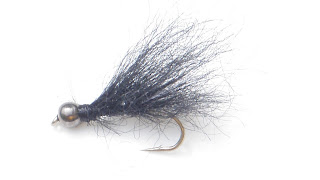
Happy Holidays!
A stick, some string and a fly.


 Trim your foam block to a length of 1 1/4 long
Trim your foam block to a length of 1 1/4 long Make a slit sut on each corner of the block, about 1/2" down from the top of the block
Make a slit sut on each corner of the block, about 1/2" down from the top of the block Trim the corners on the bottom 3/4" of your block
Trim the corners on the bottom 3/4" of your block Give it a test fit. You want a slightly snug fit. Do not try to force fit the plug, if it's too big, trim away a bit more of the foam
Give it a test fit. You want a slightly snug fit. Do not try to force fit the plug, if it's too big, trim away a bit more of the foam The foam makes a very functional rod plug. Maybe not so pretty, but by using a bright color it will be easy to find if you drop it.
The foam makes a very functional rod plug. Maybe not so pretty, but by using a bright color it will be easy to find if you drop it. Now that you have the hang of it, make an extra or two. Put a spare in fly vest/pack.
Now that you have the hang of it, make an extra or two. Put a spare in fly vest/pack.










 Top left is a 10.5' level furled line that basically serves as a Tenkara line extension. Bottom right is a 10.5' furled weight forward tapered line, top right is a 10'-12' foot tapered single strand mono leader. The furled level extension and the furled weight forward tapered line are connected with a loop to loop connection
Top left is a 10.5' level furled line that basically serves as a Tenkara line extension. Bottom right is a 10.5' furled weight forward tapered line, top right is a 10'-12' foot tapered single strand mono leader. The furled level extension and the furled weight forward tapered line are connected with a loop to loop connection

This fly was originally popularized by Carl Richards (the co author of Selective Trout / Fly Fishing Strategy). Carl and his friend/fishing partner, John Krause were guiding a client on a fishing trip along the Muskegon River (located in the lower peninsula of Michigan). The client happened to be from Chicago, and was the fisher who originally showed Carl and John the fly.
As the story goes, neither Carl or John were overly impressed with the way the fly looked, but as faith would have it, they decided to give it a try and instantly became a believers in the fish catching ability of this simple fly. Carl went on to talk about the fly during various presentations, and was said to say the Chicago leech was "The best wet fly I’ve ever found!".
John also tied flies professionally, and helped to popularize the fly by tying and selling the fly at Parsley's, a major sporting goods retailer located on the Muskegon River in Newaygo.
In honor of the Windy City client who first showed Carl and John the fly, it came to be referred to as the Chicago Fly, also known as the Chicago Leech.
It just about impossible to fish this fly in a way that won't catch fish. It can be fished dead drift (with or without an indicator), swung like a wet fly, or stripped like a streamer. Depending on how you squint, the fly can look like a stone fly/dobson fly nymph, small crayfish, leech, or a small minnow.
The original fly was tied in black, but folks have had sucess using other colors as well. The one and only one requirement, it must be tied using 100% mohair yarn. I'm not sure what it is about mohair, but it does make a difference on this fly. I personally think the fly works best when tied very sparse. Other anglers think it looks better with a fuller profile, and both versions seem to catch more than their fair share of fish. I tie the fly in a size 10 or 12, but again larger and smaller versions have been known to work well.
I think it is very much in the spirit of Tenkara. A generic, easy to tie fly that can be fished using a variety of methods.


